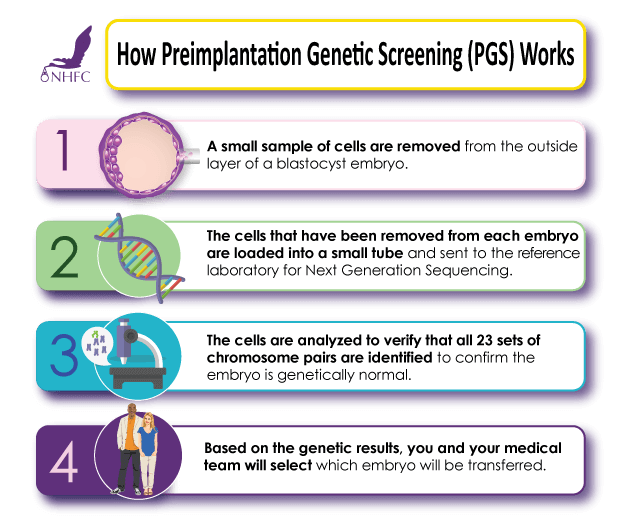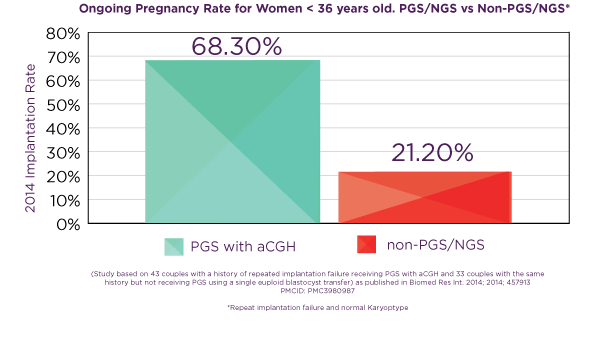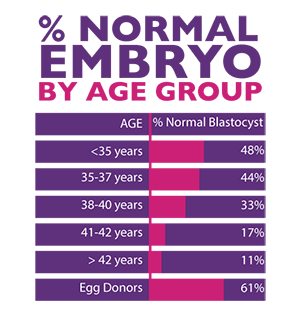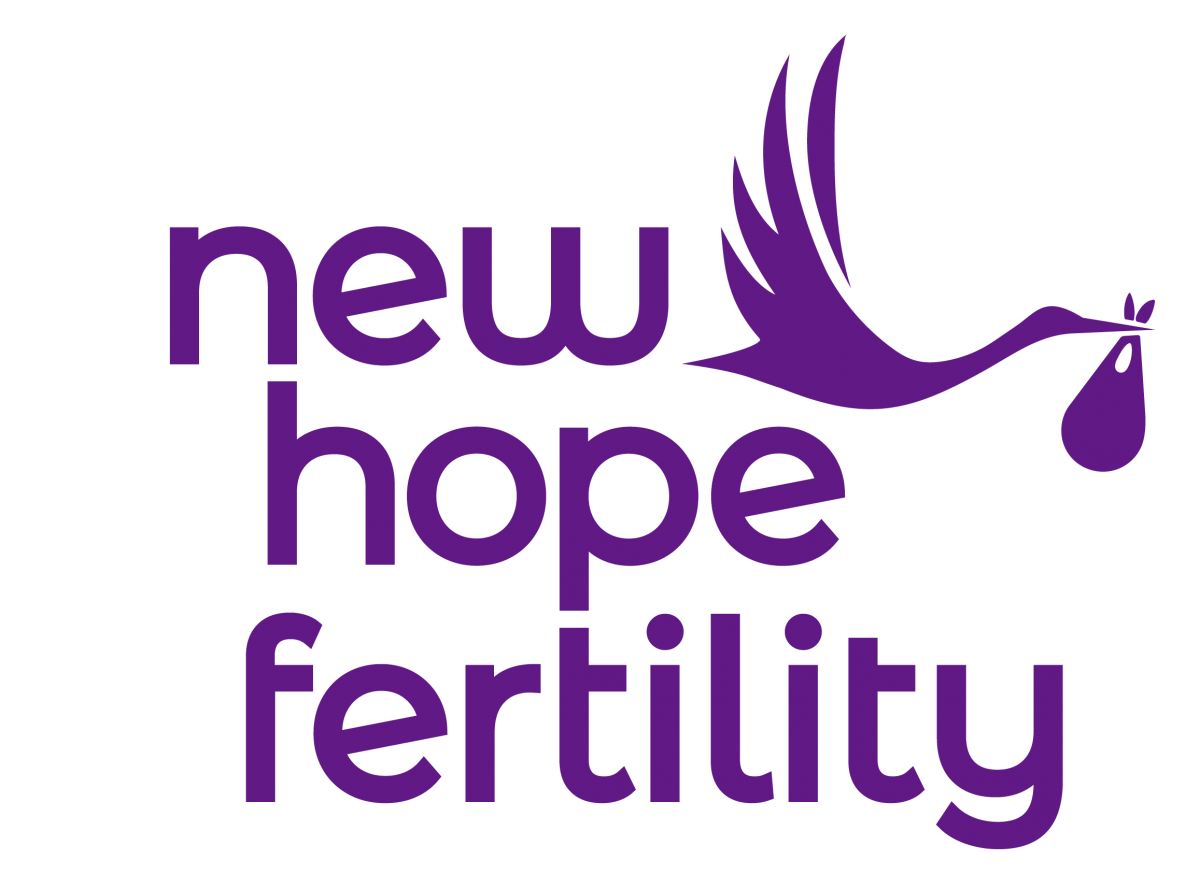
WHAT IS PGT-A?
PGT-A – Preimplantation genetic testing for aneuploidies (formerly known as PGS) – is the testing of an embryo’s overall chromosomal normality prior to being transferred to the patient’s uterus in conjunction with In Vitro Fertilization (IVF). Specifically, PGT-A identifies the most suitable and healthiest embryo to transfer by detecting chromosomal deficiencies – aneuploidy – an extra or missing chromosome.
PGT-A INCREASES PREGNANCY SUCCESS RATES
New studies show that PGT-A dramatically increases a woman’s chance of conception. This is because her doctor has the skill and expertise to identify the most suitable and healthiest embryo(s) to transfer. At the New Hope fertility clinic in New York City, embryo biopsy and screening can increase a patient’s chance of a successful pregnancy by up to 30 percent.
PGT-A VS. PGT-M
PGT-A differs from PGT-M (Preimplantation genetic testing for monogenic diseases) because the procedure does not diagnose an inherited genetic defect in the embryo. PGT-A searches for aneuploidy – extra or missing chromosomes.
In comparison, PGT-M diagnoses genetic defects such as:
- Cystic Fibrosis
- Hemophilia
- Tay-Sachs
- Sickle Cell Anemia
CANDIDATES FOR PREIMPLANTATION
GENETIC TESTING FOR ANEUPLOIDIES (PGT-A)
Because advanced maternal age (over 35) adversely affects the quality of a woman’s eggs (oocytes) resulting in chromosomal abnormalities, New Hope Fertility Center recommends PGT-A in conjunction with IVF to all patients over the age of 35.
In an ideal world, our fertility doctors would recommend PGT-A for every IVF patient. The pros of PGT-A are that you learn a lot about the health of your embryo and then can make completely informed decisions about your fertility treatment. The cons of PGT-A are cost and a 1.5 percent error rate. PGT-A findings are not infallible.
Other Candidates for PGT-A
- Women that have a history of recurrent miscarriages (2 or more)
- Women that have failed IVF cycles
- Gender Selection – Family Balancing
PGT-A DETECTS LOW-QUALITY EMBRYOS
By extracting cells from a blastocyst embryo and analyzing it, poor quality embryos are detected. Biopsy of this cell will not damage the embryo.
Low-quality embryos result in:
- Low pregnancy success rates
- High miscarriage rates
- High chance for birth defects
Schedule a Consultation
Schedule a consultation with one of the fertility specialists at New Hope Fertility Center:
NEXT GENERATION SEQUENCING (NGS)
New Hope Fertility Center in New York is committed to providing the latest and best fertility technology. NGS – Next Generation Sequencing – is a new method of PGT-A. NGS is our latest genetic screening test for primary candidates undergoing IVF. NGS is used for comprehensive chromosome testing of embryos created through IVF. NGS is on the horizon to replacing PGT-A because of the procedure’s lower cost and reduced errors.
NGS allows embryologists to screen for defects on the chromosomal level with higher accuracy and more detail than ever before. NGS results are comprehensive and a higher resolution than any other genetic testing method because it detects more translocations.
NGS may be run as a standalone test – or in conjunction with PGT-M – at a faster completion rate. NGS also detects mosaicism – when the embryo’s cells exhibit different chromosomal content.

Primary Benefits of NGS
- Reduce the number of miscarriages
- Reduce the number of IVF cycles
- Reduce the risk of a multiple pregnancy with a single embryo transfer
- Increase ongoing pregnancy rates
- Increase live births
Importance of NGS
As a woman reaches an advanced maternal age (35 and older), there is a greater chance that her low-quality eggs will create chromosomally abnormal embryos. The primary goal of NGS is to transfer embryos that have been found to have a normal chromosomal number – euploid.
Embryo morphology – how the embryo looks – alone as a means of selection for transfer is not the best tool. It is best to couple PGT-A with NGS to eliminate the chance of good looking embryos being abnormal.

NGS (NEXT GENERATION SEQUENCING)
Next Generation Sequencing (NGS) is the latest genetic screening test for fertility patients and is a form of PGT-A. It allows embryologists to screen for defects on the chromosomal level with higher accuracy and more detail than ever before. Results are comprehensive and a higher resolution than any other test and will detect more translocations. It may be run as a stand alone test or in conjunction with PGT-M and is faster to complete. NGS can also detect mosaicism which is when the embryo’s cells exhibit different chromosomal content.
Other Candidates for PGT-A
- Reduce the number of miscarriages
- Reduce the number of IVF cycles
- Reduce the risk of multiple pregnancy with single embryo transfer
- Increased ongoing pregnancy rates and live birth rates

WHY IS NGS IMPORTANT?
- As maternal age increases, more embryos are chromosomally abnormal
- The main goal of NGS is to transfer embryos back to the uterus that have been found to be euploid (having normal chromosomal numbers)
- Embryo morphology (how the embryo looks) alone as a means of embryo selection for transfer is not the best tool. It is best to be coupled with NGS. We have found that even the best looking embryos can be genetically abnormal.

